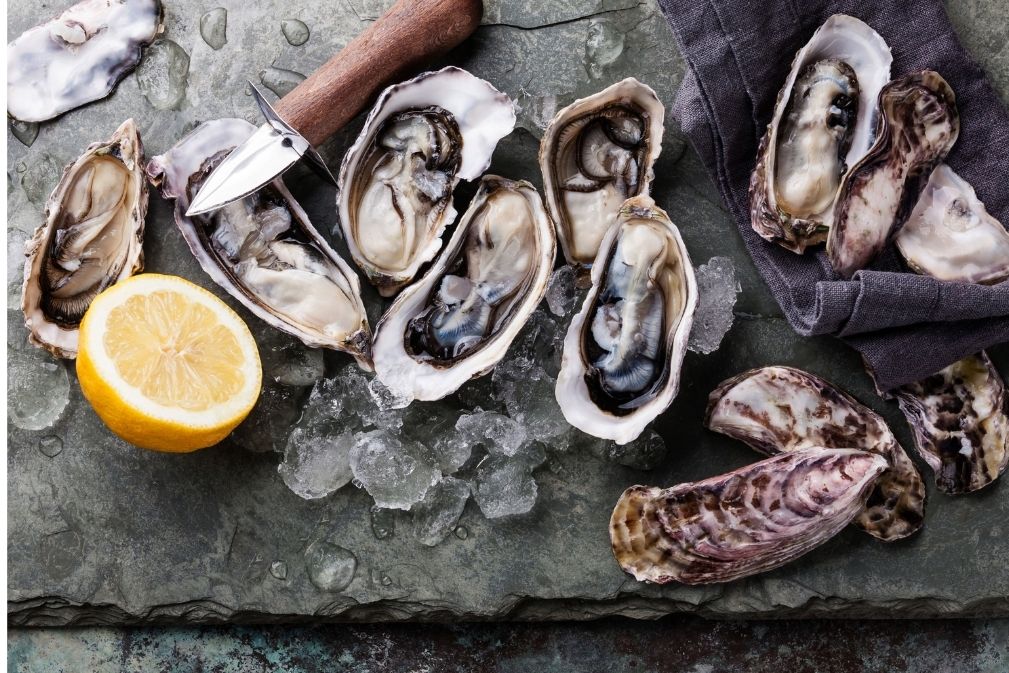All about oysters
You can absolutely eat
fresh oysters all year round, but peak oyster season is the
months ending in "R." Now, for the next questions: How do you
pick the best oysters? How do you shuck them? How should you
cook them? We've put together a little guide to help you
navigate the complex waters of the oyster world.
There's an oyster for everyone
The east and west coasts of Canada have over a hundred varieties of
oysters, boasting a wide range of textures and flavours-delicate,
meaty, briny, sweet. Here are just a few of the oysters on offer
from our
fish markets.
Shiny Sea
Origin: Prince Edward Island
Texture: Plump, juicy and full
bodied on the palate
Flavour: Salty, with a subtle, sweet finish
Merasheen Bay
Origin: Newfoundland
Texture: Plump
Flavour: Briny and
mineral, with a cold, sharp taste of seawood
Raspberry Point
Origin: Prince Edward Island
Texture: Supple and substantial
Flavour: Salty, with a briny finish and floral notes
Lucky Lime
Origin: Prince Edward Island
Texture: Rustic, firm and plump
Flavour: Salty, with notes of seaweed and a citrus tone finish
Rustico
Origin: Prince Edward Island
Texture: Firm
Flavour:
Semi-salty, vegetal, with a sweet finish
Malpèque
Origin: Prince Edward Island
Texture: Round, juicy and
light-bodied
Flavour: Perfect balance of sweetness and brine
Caribou
Origin: Nova Scotia
Texture: Plump, quite firm
Flavour:
Slightly salty, brackish flavour with a vegetal finish
Beausoleil
Origin: New Brunswick
Texture: Refined and light, with full
bodied, firm flesh
Flavour: Sweet and briny, with notes of
hazelnut
Trésor du large
Origin: Îles-de-la-Madeleine
Texture: Fleshy, soft and juicy
Flavour: Intense brine, with a sweet, subtle finish
Fresh test
You have to be vigilant eating raw oysters. Your shellfish
should be unmistakably fresh. Choose your oysters carefully, and go
for ones with heavy, tightly shut shells. Avoid oysters with shells
that are slimy or covered in algae. Make sure to throw out any
oysters with an open bill, as they're likely dead. Another sure-fire method is the smell test: oysters should have a mild,
pleasant ocean smell. When you open them, they should be plump and
glistening, with a clean, clear liquor.
The best way to shuck an oyster
- Firmly hold the oyster in a clean cloth, with the shell in
the palm of your hand and the pointed end (the hinge) toward your
wrist.
- Work the tip of a knife into the hinge and twist to pop
the two shells apart.
- Run the knife along the side of the shell to sever the
muscle, separate the flesh of the oyster and pull the top shell
off. If there are any shell fragments, use the tip of the knife to
scrape them out.
- Be careful not to discard the liquor. Place the opened
oysters on a bed of coarse salt or ice and serve immediately.
The world is your oyster
There are so many ways to eat oysters. They are delicious raw with
a bit of fresh lemon juice or a few drops of hot sauce. You can
also serve them topped with mignonette, a mix of shallots, vinegar
and your choice of seasoning. Oysters are also great cooked, so fry them,
grill
them or serve them au gratin.
Drink pairings
The delicate flavours of oysters pair wonderfully with dry
white wines featuring mineral notes, such as wines from Chablis,
Muscadet-Sèvre et Maine or Sancerre. If you want to get a bit more
festive, you can also serve them with some bubbly. Who'd say no to
oysters with champagne or cava?

